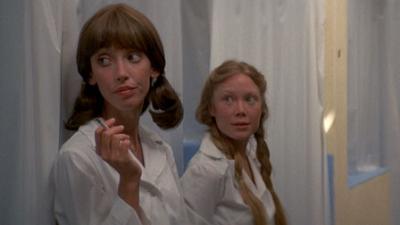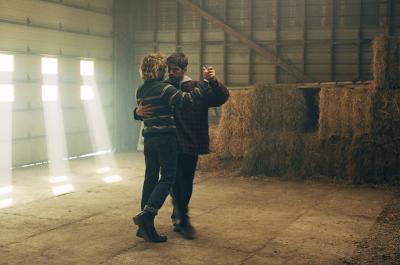
At the beginning of both Xavier Dolan’s film, Tom at the Farm (2013, original title Tom à la ferme), and Noah Baumbach’s Mistress America (2015), someone is arriving at a place they have never been, a place mysterious, challenging, and at first vaguely threatening. These characters seem somewhat naïve, lacking agency, yet as the film progresses they gain power as another character cedes control.
Both films pull us in through the initially familiar; if you’ve driven from upstate New York to Montreal, the opening shot of Dolan’s film, a car racing through the flat beauty of northern farmland, is immediately recognizable. This is also structurally familiar for suspense; what lies in wait at the end of that road? Tom (played by Dolan) is the young man driving to the family of his deceased boyfriend Guillaume. Upon arrival, it becomes clear this lover never told his family about Tom. The family home, an isolated hive of repression, with distant mother Agathe (Lise Roy) and hostile brother Francis (Pierre-Yves Cardinal), holds Tom down for examination, with Guillaume’s never fully explained death (and life) the illusive prey.
In Baumbach’s film, the protagonist, a young student named Tracy (Lola Kirke), opens the door to an unwelcoming roommate and we are misled into expecting a college comedy. The film takes another route, focusing on the intense friendship that soon develops between Tracy and Brooke (Greta Gerwig), the daughter of the man Tracy’s mother is about to marry. Tracy becomes an audience for the much more worldly Brooke, whose life, at least on the surface, promises far more to Tracy then that of her collegiate circle.
In prior Dolan films (I Killed My Mother, Heartbeats), the young Québécois actor/writer/director portrayed a central character difficult to fully understand. In Tom at the Farm, the protagonist’s grasp on power is particularly opaque. Part of Dolan’s charm as an actor in previous films has been that as the central performer he’s so adorable and so irritating, clever yet conniving. He switches it up this time; you want to be on his side, but on whose side is the character himself (or the director)? The script, Dolan’s adaptation of a theatrical play by Michel Marc Bouchard, emphasizes the ambiguity of the central character. Our feelings flutter; why does he remain at the farm after Francis attacks him?
Baumbach has a somewhat different way of operating. He wrote the script with Gerwig, collaboratively constructing her character. As with their prior project, Frances Ha, the script gives the actors much to explore, the nuttiness of Gerwig’s character never falling into male fantasy-female territory as she reveals herself to be both more and less nuanced than expected, while Kirke’s slowly matures in front of us. The earlier film suggested that with Gerwig, in particular, the actor/character synergy which differentiates a movie star from an actor might be in the making, something Mistress America clinches. We are watching Gerwig, as much as her character, develop.

Much of the action in both films comes through close-ups, realization and recognition playing over a face. Between Brooke and Tracy in Mistress America, there is, as in The Great Gatsby, observation of a flawed and self-doubting power by the admiring subaltern, looking up but also looking down, observing the knots (and “nots”) inside a series of assumptions. Tracy watches intently, while Brooke seems unconscious of her own effect. Scottie Fitzgerald supposedly said about her parents, “they left wreckage behind,” exactly what Tracy records in Mistress as this story moves through and beyond such wreckage. With Tom at the Farm, watching Dolan react to the building horror around him, his face registering something his actions subsequently belie, pulls us deeper into the mystery of his persona.
In both films, homosocial tensions manifest as the need to be loved, to be looked at as a major subject or even target, to matter deeply to someone you are driven into intimacy with, even as the object of attraction uses a baffling series of on/off jolts to disorient that desire. It’s difficult to watch Mistress America and not think of Robert Altman’s 3 Women (1977), though the passive character of Pinky (Sissy Spacek) in that film is here a much more empowered figure, a young student and writer, someone keeping very careful notes, pulling power firmly back into her own hands even as she reverently observes Gerwig (an analogue of Shelley Duvall’s Millie in the Altman film) slowly fall apart.

Betrayal, as well, seeps deeply into both films. With Dolan, that betrayal is much more basic, not directed solely towards his antagonist Francis, but also at a putative friend who arrives to perform the role of ex-lover’s girlfriend. There is no victory or redemption, as any reclaiming of power is accomplished through flight more than fight. With Baumbach, the betrayal is a creative act, the goal of which is not consciously destructive, and ultimately deepens our sympathies for Tracy as well as Brooke. In both films the protagonist is isolated, set apart, unable to rely on the assistance of others. In Tom at the Farm we are watching a young gay man out of his safety zone, marooned in a place where who he is and why he is there cannot be spoken of, a power struggle grounded in humiliation and submission. Tracy’s isolation, less ominous than Tom’s, comes from a desire to move both out and up in the world. Tom’s motivations remain much less clear.
The initially powerful antagonists, Francis and Brooke, fill loss by pulling others into their web, a logic which sets into motion a generative destruction, as the protagonists, Tracy and Tom, realize just what they have been drawn into and how they will write, or writhe, out of it. Both films show us the perils of callow fascination, of being drawn into a situation and system you don’t fully comprehend, with targets whose reciprocation takes a very different form. In the Dolan film, his character is subjected to violent rejection, yet that resistance pulls him tighter to its source. In Mistress America, the disarmingly casual campaign for intimacy conducted by Brooke (yet initiated by Tracy) goes from centripetal to centrifugal; just who causes that reversal?
Both films could have been made in an earlier time, perhaps the 1990’s. This is especially true of Tom at the Farm. The central peril of Dolan’s character, how to speak to the family of his recently deceased boyfriend, a character we never see and whose cause of death is never clarified, harkens to early AIDS dramas. Yet this is offset by the lack of explicit homo-phobia; the general level of fear in this film is so high, who needs specifics? The loathing aimed at Dolan’s character seems rooted in some other place, one never fully revealed. That mystery makes the film’s atmosphere ever more uncomfortable. The antagonists never fully reveal what is motivating their behavior, controlling their surroundings and situations with maniacal rigor.

A dramatic midpoint comes when the protagonist, wandering from the central situation, encounters the “normal” (in Dolan’s film the townspeople, in Baumbach’s other students), and feels estranged while palpating the tense membrane between them. The most inexplicable behavior seems to be coming not from that antagonist as from their prey. In these films a disconcerting lack of condemnation by the main characters towards their oppressors (perhaps liberators?) is more revealing and generative then rejection or revenge. An apprenticeship, one relatively benign in Mistress America, and the other quite dangerous in Tom at the Farm, settles in as one character observes another and allows themselves to be seduced. Manipulated by a controlling character desperate to curate, control, and choreograph their environment, the protagonists don’t so much push back as work-around, bend, flex and stand in awe.